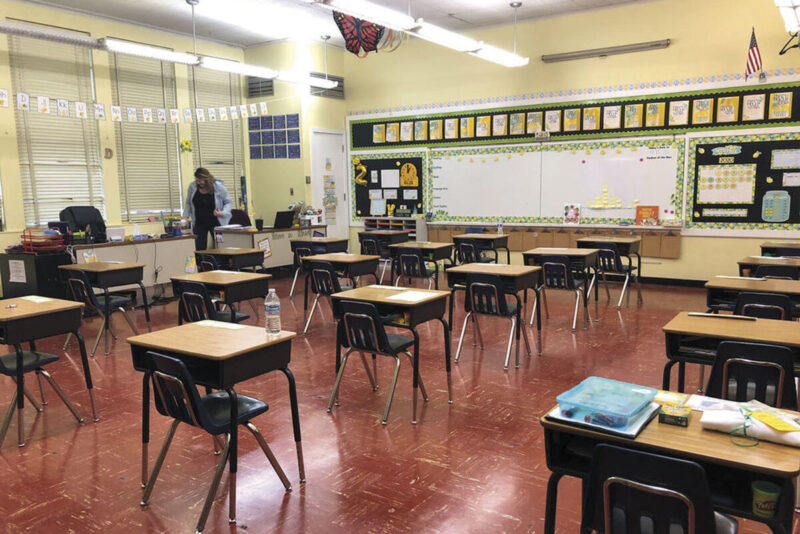Kelly Kenoyer
Between windstorms, smoke, evacuation orders, and power outages, schools across East Linn County had rough starts to a school year already complicated by a global pandemic.
While Linn County has COVID numbers low enough to allow kindergarteners through third graders to attend school in person, the district has decided to hold off on in-person classes until October.
In the midst of all these challenges, Sweet Home Charter School may be a forerunner for Sweet Home: grades K-3 started classes in person last week, while older kids are currently set to come in twice a week for two hours of in-person learning.
The in-person classes haven’t been without their challenges. Stormy weather last week canceled classes at the school on Sept. 18, said Principal Jeff Tompkins.
“We didn’t have any internet either, so we couldn’t do any distance learning from campus, and presumably families were in the same position too,” he said. “It’s a battle in flexibility. The first week was the week we had fire and smoke.”
Still, he said the first few days of distance learning have gone fairly well, tech issues notwithstanding.
“It’s a struggle, but I’m seeing significant strides even within two days,” he said.
Tompkins said several new students enrolled recently, bringing the Liberty-area school’s total enrollment to 135. That’s slightly down from last year ‘s 143 enrolled students, largely because some families have switched to home schooling, he said.
Students came in person in groups of five at staggered times to meet their teachers and do some testing, he said, and then older students had two full days of distance learning Wednesday and Thursday, while younger kids came in person for classes those days.
For 9-year-old Fawna Mountain-Foxx, a fourth-grader at the Charter School, that taste of school in person was very exciting. She packed her backpack with tons of books, she said.
“It was the heaviest backpack ever.”
Online classes don’t have the same thrill, though.
“I don’t like it because it’s frustrating and it always glitches and we always need to wait for everyone,” she said. “Most of the whole Zoom meeting is just waiting.
“I wish we could just go to school.”
Students like Fawna will get to go in-person part of the time, even though they aren’t permitted to attend on campus for all classes.
Older students are allowed to come in for “limited in-person instruction” a few times a week for a maximum of two hours a day, Tompkins said.
“It’s for connectivity and for instruction and activities they can’t be easily replicated away from school.”
Those sessions are limited to 10 students at a time, and are set to start right after distance learning each day, around 1:15 p.m.
Online schooling itself can be “chaotic,” Tompkins said, but it’s “a learning curve.”
That’s why some of the few hours of in-person instruction are partially for tech support.
“I think, once we learn Zoom, Google Classroom, the platforms that we’re using, it will become easier,” he added.
It’s even harder if the student has no one supervising, or if the parent is working and an elderly caretaker is in charge who doesn’t understand the technology.
“There are frustrations as we get started, definitely,” he said, but he said the first weeks are largely about learning the tech, and once students are fluent in using it, it will be easier to move on to lessons.
Fawna’s mother, Cassie Foxx, said she feels bad for parents who aren’t able to help their kids with school full-time. Between Fawna in fourth grade and her little sister Freya in preschool, Foxx said, “I’m running back and forth all day.”
“They’re like, ‘Hey, it’s break time! Let’s go have a healthy snack.’ And I’m like, ‘You expect me to have time to prepare all these snacks?’ When I’ve been doing her work with her? Yeah, it’s like now I’m a teacher, too,” Foxx said, frustrated.
The few hours of in-person instruction make it a little better, though.
“It was so nice to go walk her into school,” Foxx said. “We just want the schools to open up again.”
For younger students who are in person now, there is a whole lot of health monitoring, Tompkins said. Students who are out sick are required to stay home for at least 72 hours, so teachers have to be in good contact with families to make sure the kids still get their school work and don’t fall behind.
The school will go on high alert if 20 percent of students in a class get sick in a given day, which is just four students with small class sizes.
Tompkins said part of that planning is a matter of working with parents to be honest about why a student is missing school.
“If it’s hunting, we may not excuse that, but we don’t want that student to count as sick if that student will be the one who pushes us over,” he said.
That kind of outbreak would mandate contact with the county Health Department, and may require the class to go to remote learning.
Contact between students is also limited to those within their own classroom, he said, so schedules have been staggered to allow each class to get lunch in the cafeteria and take it back to the classroom before the next group goes. Similar staggering is scheduled for recess, and the playground is cleaned in between classes, he said.
Within the classroom, children need to wear masks and have their own separated desks which are spaced 6 feet apart. So far, Tompkins said that has gone pretty well, even for really young students. “Because they have to do it when they’re shopping, there’s overall acceptance” of masks, Tompkins said.
One perk from the extended hiatus from in-person instruction, though, is how excited students are to come back to school.
“I’ve seen students who I would have said were checked out or not wanting to do school, they would say ‘No, school sucks, I don’t like it.’ And that attitude changed there because they missed it,” Tompkins said.
For older kids who are still remote, Tomkins is hopeful that they’ll get over the hump of learning the new remote technology and be able to start really learning their lessons soon.
Foxx is hopeful that it will get better soon too, and she supports the Charter School and wants to stay.
“It’s just going to take time to get used to it,” she said.





